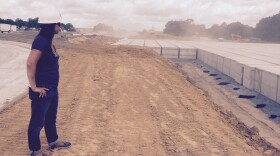The V.A. is building columbariums at several veterans cemeteries, where there is no more space for traditional burials.
A headstone in Section 89A marks the grave of Staff Sergeant Andrew Harvell. A temporary marker notes that his brother, Sean Harvell, is buried there as well.
In a patch of weeds and rebar, a stone's throw from the 405 Freeway, lies the Los Angeles National Cemetery's overcrowding solution—the planned site for a new columbarium, expected to open to burials in 2020.
"All this will be redone and become beautiful just like the national cemetery across the street," said Tom Ruck, director of the cemetery, on a recent tour of the site on the Veterans Affairs campus in West L.A.
The columbarium—basically a wall that can hold urns of cremated remains—has become a go-to solution for veteran cemeteries across the nation as space runs out. Similar structures are being built in veterans cemeteries in Chicago, New York and Alameda.
Generally, veterans are given the burial of their choosing, paid for by the VA, whether that's sprinkling ashes at sea, being interred in a sunken Navy vessel, or burial in a national cemetery.
But effectively, because of space issues, many cemeteries are currently off limits.
In Los Angeles, which has the largest veteran population in the nation, the cemetery has been closed to most casket burials since the late 1970s. Most area veterans are referred to Riverside if they want a casket burial.
The cemetery did clear a new spot after 9/11 to inter service men and women killed in combat in Iraq and Afghanistan.
One of the freshest graves belongs to Sean Harvell, an Air Force Combat Controller who drowned last month off Alamitos Beach. Harvell, who served in Afghanistan, received two Silver Stars, multiple Bronze Stars, and a Purple Heart.

His family was able to bury him close to his mother, who lives in Long Beach, only because his casket was buried on top of that of his younger brother, Andy Harvell, killed less than five years ago while serving on SEAL Team 6's Gold Squadron.
Andy was on a rescue mission when the Taliban shot down the helicopter carrying him and his team. Because Harvell was killed in action, cemetery officials made one of the last remaining burial plots available to him. Andy's wife gave gave her approval so the brothers could be laid to rest together.
"They were as close as twins is the best way to say it," said their uncle, Bill Maher. "It was always Sean and Andy, and that’s how we talked about all of them all the time, it seemed. They were a pair."
The two are now among the 89,000 veterans and spouses buried in the cemetery.
"So America can say ‘thank you’ one last time for the service they gave to this great country," Ruck said.
Mary Elizabeth Jones, an administrator at the cemetery, said the V.A. is looking forward to the expansion.

"There's a large population of veterans and we haven’t been able to really serve them for many years," she said.
One of them is Paul Lally.
Lally served in the Air Force from 1952-956 and he's left instructions with his children that he wants to be cremated and have his ashes interred in the new columbarium.
"It's an honor, really," Lally said. "For one reason or another we decided to serve our country. We've done it and we've done it honorably, and therefore we have a right to be buried there with some dignity and that's the place to do it."




